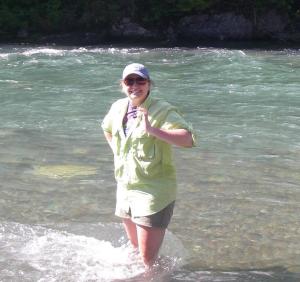
In short, the eastern tiger salamander is in danger.
However, Dr. Valorie Titus, a professor of environmental science at American Public University, is studying these little amphibians and working to conserve their species.
Dr. Valorie Titus currently teaches wildlife, conservation, and ecology courses in the Environmental Science program within the American Public University School of Science, Technology, Engineering, and Math. She completed her dissertation work on the eastern tiger salamander at Binghamton University and her Master’s work on copperheads at Murray State University. She has also worked for the Wildlife Conservation Society (WCS) as a Curatorial Science Fellow in Herpetology at the Bronx Zoo, where she did research on captive wildlife behavior, and fieldwork on the effects of urbanization on reptiles and amphibians. Following this fellowship, she also worked for WCS as a research associate studying the ecological recovery of bison.
She joined the faculty at Green Mountain College as an assistant professor of natural resource management in August (2014).
Life Zones and Corridors: Management of the Eastern Tiger Salamander
![]()
Amphibians throughout the world are declining at an alarming rate. Lack of natural history data on amphibian populations – such as studies of habitat use, movement patterns, and how groups of individuals interact–makes it difficult to really come up with proper management plans for these species.
Technological advancements have enabled the rapid assessment of populations, as well as the beginning of long-term studies of amphibian species. For some species, these technological advances may be too little too late, but for others, a better understanding of the behaviors and habitat use of individuals can lead to proper management and species survival.
The eastern tiger salamander (Ambystoma tigrinum) is listed as endangered in New York State and only found on Long Island. While this species occurs throughout the Eastern US, it appears to be declining.
 I studied the natural history of this species by using radiotelemetry and population genetics. Due to rapid habitat loss on Long Island, it was critical to study this species so responsible actions could be taken to preserve the species. Until recently, the zone of protection for the wetlands in which these animals breed was 100 feet surrounding the wetland with up to 500 foot corridors to maintain connections with adjacent wetlands. These animals are fossorial most of the year, and this zone of protection was considered to be insufficient to protect critical breeding populations within upland habitats.
I studied the natural history of this species by using radiotelemetry and population genetics. Due to rapid habitat loss on Long Island, it was critical to study this species so responsible actions could be taken to preserve the species. Until recently, the zone of protection for the wetlands in which these animals breed was 100 feet surrounding the wetland with up to 500 foot corridors to maintain connections with adjacent wetlands. These animals are fossorial most of the year, and this zone of protection was considered to be insufficient to protect critical breeding populations within upland habitats.
My objective was to measure the extent of movement into upland habitat and to genetically estimate connectivity between individual breeding ponds on Long Island. I used radiotelemetry to monitor movements of emigrating individuals from breeding ponds to measure the extent of travel into upland habitat. I used drift fences, dip nets, and seines to collect tissue samples from different Long Island populations to measure genetic variation.
My study indicated that female and juvenile tiger salamanders travel significantly farther than males into upland habitats. The animals preferred the native pitch pine and oak forested habitat for their refuge sites. Based on these data, I recommend that each wetland should be considered on a case-by-case basis, maximizing the amount of preferred habitat available to the salamanders, due to differences in surrounding habitat availability. Though exact numbers of each size and sex class required to maintain a viable population was not determined in this study, it is still essential to the survival of these populations to maintain sufficient habitat to ensure that a healthy number of breeding females can survive and to ensure juvenile survival to breeding age.
The future of this species in New York could be positive, if management plans acknowledge the need for larger zones of protection and connectivity between breeding wetlands. Proper life zones, as well as providing corridors for genetic connectivity, can reduce the immediate risk to this species, though more long-term management plans need to be considered.
